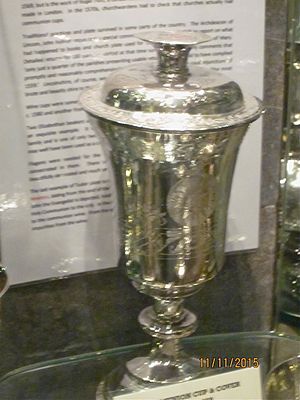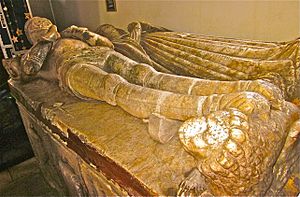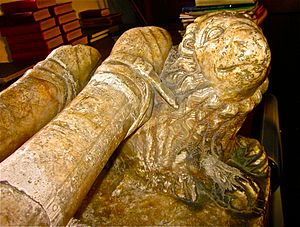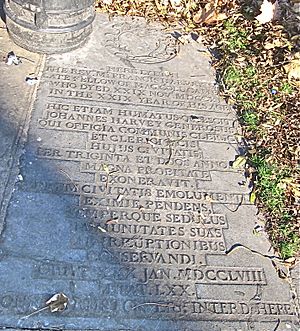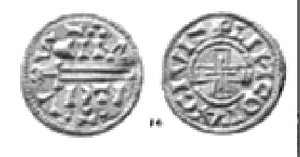St Martin's Church, Lincoln facts for kids
Quick facts for kids St Martin's Church, Lincoln |
|
|---|---|
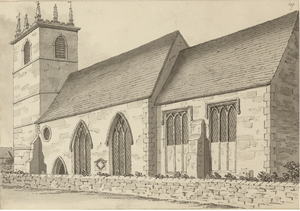 |
|
| Lua error in Module:Location_map at line 420: attempt to index field 'wikibase' (a nil value). | |
| Location | Lincoln, Lincolnshire |
| Country | England |
| Denomination | Church of England |
| History | |
| Consecrated | 9th–10th Century |
| Architecture | |
| Style | Georgian |
| Years built | 1740 |
| Administration | |
| Diocese | Lincoln |
St Martin's Church was one of the oldest churches in Lincoln, England. It no longer stands today. The church was rebuilt in 1873 but was then taken down in 1879.
Some people think that Saint Martin was the special saint of Lincoln. This might have been during the Anglo-Saxon period. It was also during the time of the Danelaw, when Vikings ruled parts of England. The church may have been linked to rare silver coins. These coins, called St Martin pennies, were made in Lincoln. This happened before 918 AD, when the Anglo-Saxons took Lincoln back from the Danes.
Contents
History of St Martin's Church
The church was located at the top of Lincoln High Street. This area is in the lower part of Lincoln. From there, the land rises steeply to 'uphill' Lincoln. Lincoln Cathedral stands proudly in the uphill area.
Medieval Times and Rebuilding
During the Middle Ages, the area around St Martin's Church was Lincoln's main shopping center. It was very close to the Norman Jew's House and Jews' Court.
In 1643, during the English Civil War, the church was mostly destroyed. It remained a ruin until 1739–40. Then, it was rebuilt in a Georgian style. An artist named Samuel Hieronymus Grimm drew this church around 1784. Around 1812, a new section was added by William Hayward, an architect from Lincoln.
Later Demolitions
In 1873, people suggested tearing down the whole church. They wanted to build a much bigger church. The Mayor of Lincoln stepped in and saved the church tower. This tower was a well-known landmark in Lincoln. It stayed standing until about 1930, when it was finally taken down.
Many decorative stones from the old church were used in a new church. This was St Andrew's in Canwick Road, built in 1876–77. However, St Andrew's Church was also demolished in 1970.
St Martin's Church was rebuilt again in 1873. This new church was on West Parade, at the corner of Orchard Street. The architect was A S Beckett. In 1966, there was a request to demolish this replacement church. After a legal hearing, the building was taken down in 1970.
What Remains Today
Today, only the graveyard of St Martin's Church remains. It is located between St Martin's Lane and Garmston Street. The graveyard has been paved. Some of the old grave-slabs from the church were used for this paving.
Objects That Still Exist From the Church
Church Silverware
Some items from the church still exist. These include the communion plate. This set had three silver communion cups with special covers called patens. It also had two silver flagons (large jugs).
One of these cups, with its paten cover, was made in London in 1569. The maker is unknown, but their initial was 'A'. This cup is now on display in the Treasury of Lincoln Cathedral.
Monument to Sir Thomas Grantham
The Grantham family was very important in the church's area for a long time. Their family monuments were in the north side of the church's main area, called the chancel.
One special monument is a beautiful Renaissance style tomb. It is for Sir Thomas Grantham (who died in 1630) and his first wife, Frances (who died in 1610). Sir Thomas was a Member of Parliament for Lincoln. This monument is now in the church of St Mary le Wigford in Lincoln.
The tomb is made from alabaster stone from Nottingham. It was likely created by the famous sculptor Maximilian Colt. This tomb has had a very difficult history. In 1807, when Edward James Willson visited the church, he found that the top part of the tomb had fallen. It had broken the faces of the figures lying on it. Later, it was moved into the church tower.
In 1889, a Mr Justice Grantham, who said he was a descendant, moved the tomb. He took it without permission to Barcombe in East Sussex. The broken pieces of the figures were brought back. They were placed in St Benedict's Church in Lincoln. In 1956, Sir Francis Hill wrote that the damaged pieces lay there after "unseemly neglect and ill-usage."
Before 1985, the main part of the tomb and its pieces were put back together. This happened in St Mary le Wigford church. The Church Monuments Society recorded this event. Since then, more parts of the figures have appeared. This includes the lion where Sir Thomas rests his feet. The figures have been arranged again.
Grave Slab for Rev. Francis Harvey and John Harvey
Among the grave slabs used as paving in St Martin's Churchyard is a beautiful memorial. It is for the Rev. Francis Harvey, who died at age 29 in 1711. It also remembers John Harvey, who died in 1758. The grave slab has special cameo lettering. It is on a black marble slab with the family's coat of arms above.
There are two very similar black marble slabs in Lincoln Cathedral. These are at the east end of the chancel. These unique grave slabs were probably made in a local workshop.
Details about Francis Harvey are in a book called Alumni Cantabrigienses. He was the son of Francis Harvey of Lincoln. He went to school in Newark. In 1708, he became a fellow at Magdalene College, Cambridge.
The St Martin of Lincoln Silver Penny
These silver coins are very rare. They were made in Lincoln just before the Danes stopped ruling the area. One side of the coin has a sword. It is roughly lettered "Sancti Marti," which means Saint Martin. The other side has a cross. It is lettered "Civit Lincolia," which stands for Lincoln.
It is thought that St Martin was the patron saint of Lincoln at that time. These coins might have been made near St Martin's Church. This was the main business area of Lincoln back then.
About 14 of these coins are known today. One from the Sir Francis Hill collection is in the Usher Gallery in Lincoln. A very good example of a St Martin penny was found in the Vale of York Hoard in 2006.
See also
- Churches in Lincoln


